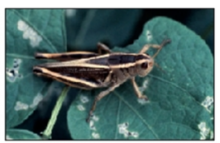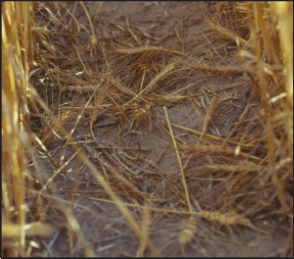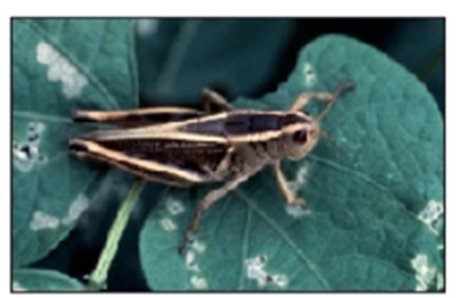Plant Damage and Response
Damaged kernels appear partially hollowed (Figure 7.31). Kernel damage will vary from slight to severe, and many of the most severely damaged kernels are likely to be blown out through the combine. Damage to kernels is difficult to distinguish from that of certain stored product pests and can be classified ‘IDK’ (insect damaged kernels).
Management
There are no established management plans for this pest. Infestations are usually concentrated around field margins so scouting efforts for this pest would need to include interior transects to obtain a representative estimate of population levels. In addition, no economic threshold has been determined. There are no materials specifically labeled for this pest, but materials registered for other armyworms in wheat would likely provide control if applied sufficiently early. However, unless detected well in advance of crop maturity, treatment would be impractical because the preharvest interval requirement of most insecticides would cause even greater losses due to delayed harvest. Larvae arriving in storage bins with harvested wheat either die or emerge as moths, and they are not a concern in stored grain.
Grasshoppers can be found across the Great Plains, but most damage occurs in areas with less than 25 inches of annual rainfall. In most years, the western Great Plains falls into this higher risk category and is susceptible to grasshopper outbreaks. Grasshopper damage to winter wheat occurs during two periods. First, wheat establishment can be impacted when grasshoppers move into the emerging crop in the fall. Also, grasshoppers can move into wheat in late spring when wheat is headed and cause serious damage.
Identification / Life Cycle
Four grasshopper species, the migratory, differential, twostriped, and redlegged, cause nearly all the damage to cultivated crops (Figure 7.32 & 7.35). They prefer habitats with a variety of host plants, including both grasses and broadleaf weeds. As a result, they prefer cropland settings with nearby undisturbed areas such as roadside ditches, crop borders, abandoned cropland, and overgrazed pastures or rangeland. Field crop problems usually do not arise from neighboring well managed rangeland or pasture.
Female grasshoppers lay their eggs in pods, laying 8 to 30 eggs per pod and a total of about 100 eggs during the summer and fall. The potential for outbreak increases when females produce more eggs as a result of better food quality or an extended fall which allows more time to lay them. Egg pods are deposited in the upper few inches of undisturbed soil in grasslands, pastures, ditches, and field borders. No-till fields also may have inaeased risk due to potential egg laying throughout the field. Eggs are woll insulated by the pod and soil and can survive extremely cold temperatures as trey overwinter. Hatching time is strongly infuenced by temperature, with earlier hatching occurring after a warm spring. The twostriped grasshopper is the earliest hatching grasshopper of concern in cropland with eggs beginning to hatch from mid to late May. Eggs from remaining species begin to hatch from one to three weeks later. Hatching will continue into June. Nymphs start feeding immediately after hatching and usually feed on the same plants as adults. Because of limited fat reserves, nymphs are very vulnerable to adverse weather just after hatching, and extended cool temperatures (less than 65°F or l8°C) and rainy weather can result in extreme nymphal mortality due to starvation. Grasshopper nymphs go through five developmental stages or instars. After each instar, they shed their cuticle and grow larger, developing into adults in five to six weeks. In most years, adult grasshoppers are present by late June and early July. Adult grasshoppers, the only instar with wings, can readily move out of hatching areas.
Figure 7.32 Migratory grasshopper.
Figure 7.33 Differential grasshopper.

Figure 7.34 Twostriped grasshopper.
Figure 7.35 Redlegged grasshopper.
Plant Damage / Response
Grasshoppers cause defoliation as they consume and also clip foliage. In the fall, early seeded winter wheat is more vulnerable to injury than later plantings because plants emerge while adult grasshoppers are still actively feeding. Newly emerged wheat can be severely damaged by grasshopper feeding, resulting in stand loss. lncreased grasshopper pressure also may occur after a light fall frost that kills broadleaf weeds, this forage source may move quickly into winter wheat and cause damage; however, a heavy frost will reduce or eliminate local grasshopper infestations.
Figure 7.36 Grasshopper feeding habits cause heads and stems to fall to the ground.

In the spring and early summer, grasshopper damage to small grains can seriously damage maturing small grains. They will defoliate wheat, but the greatest impact will occur when grasshoppers clip the stems, causing entire heads to fall to the ground (Figure 7.36). This damage is most likely to occur when grasshoppers move into wheat fields while the wheat is maturing and the stems below the heads is the only remaining green tissue.
Management
Because grasshoppers move into crop production fields from hatching beds around field borders, grasshopper surveys should be conducted in adjacent untilled areas early in the season (late May and June) to determine the potential for problems. If timely rains keep the vegetation in and around hatching beds green, the grasshoppers may not move into the maturing wheat crop.
Sweep net sampling is useful in determining the stage (instar) and species makeup of grasshopper populations. A standard 15-inch diameter sweep net, equipped with a heavy cloth net, should be used. Information from sweep net samples is particularly valuable early in the season for determining the stage of grasshopper development to optimize treatment timing and to assess the potential for damaging infestations.
The best method for determining grasshopper density in field borders or hatching areas is to count the number of grasshoppers by using the square-foot method. With practice, this approach can provide good estimates of hopper density. To use this method, randomly select a point several feet away and visualize a one square foot area around that point. When first learning this method, practice with a measured square foot area to improve your ability to visualize the counting area. Walk toward this point while watching this square foot area, and count the number of grasshoppers in or jumping out of the area. Repeat this procedure 18 times, and divide the total number of grasshoppers by two. This will give you the number of grasshoppers per square yard (9 square feet). Counting sites should be 50 to 75 feet apart and randomly chosen. Just after hatching, when grasshoppers are small, they will be difficult to see, and underestimating the true hopper density is common. Vary the vegetation in the count area, and sample both north and south facing slopes.
Thresholds
When the number of grasshoppers per square yard has been estimated, use Table 7.2 and Table 7.3 to determine if treatment is necessary. Adult grasshoppers can consume a great deal of plant material in a short time. Due to the small amount of vegetation available in emerging wheat and the life stage of the grasshoppers, light to moderate infestations in the field and borders can cause considerable stand loss along borders.
Cultural Control
A long term solution to reduce grasshopper potential is to reduce the attractiveness of abandoned or weedy areas to cropland grasshoppers by establishing a dense grass cover that includes few broadleaf plants. For winter wheat, delayed seeding in high risk fields also can reduce the potential for grasshopper damage but may not be practical, especially during a warm fall when grasshopper survival is extended.
If severe infestations are anticipated, field margins can be planted at a higher (double) wheat density to allow for some plant loss. Planting at increased density would only be needed on field edges in the first one or two passes with the drill.
Table 7.2 Spring treatment guidelines for immature and adult grasshoppers in winter wheat (modified from University of Minnesota information).
Table 7.3 Fall treatment guidelines for adult grasshoppers in winter wheat (modified from University of Minnesota information).
Chemical Control
Grasshoppers are easiest to control as nymphs. If a range of rates is listed for a given insecticide, the higher rates generally should be used to control adults. Grasshoppers can be controlled by using sprays or baits. Read the label thoroughly before any insecticide application, and follow safety instructions and precautions. When spraying borders adjoining cropland, be sure to read and follow label restrictions on grazing. The treatments discussed here should provide adequate control of low to moderate grasshopper infestations. If grasshopper counts are high, control will be difficult.
Baits. One option for grasshopper control is a bait formulation. Carbaryl-based bran bait is available as a two percent or five percent formulation. This method can provide good control when applied just before winter wheat emergence, when crops are only a few inches tall, or in areas with short, dry vegetation. Success depends on uniform distribution of the bait and reapplication if the bait is no longer attractive to grasshoppers. Moisture (rain or heavy dew) will reduce the bait attractiveness substantially.
Border Treatments. In most years, treating the crop margin or the border area surrounding the crop is adequate for control. A border treatment of 150 feet beyond the crop edge should be adequate in most situations, depending on the size of the grasshopper source area, but season long control may require up to a ¼ mile border treatment when the population source is large. With large infestations, control may be difficult, and multiple border treatments may be required. Using insecticides with the longest residual activity would be most effective. The residual activity of the treatments will vary with the chemical and environmental conditions. It is important to monitor the border areas and crop margins after treatment to make sure grasshoppers do not reenter the field. Timing of border treatments is critical for optimum grasshopper control. The best time to spray the borders is just before the wheat emerges. If an application is made too early, there will be no residual insecticide activity in the borders when the wheat emerges, and grasshopper populations may build back too quickly. If it is applied too late, some of the earliest emerging wheat may already be damaged.
Planting insecticide treated seed can help control grasshoppers in emerging wheat. Imidacloprid (Gaucho) and thiomethoxam (Cruiser) seed treatment can be effective when hoppers are present at moderate levels. These seed treatments can only be purchased on pretreated seed. Once in the soil, the chemical is taken up by the germinating seed and seedling and is ingested by feeding grasshoppers. Grasshoppers can still damage the wheat, but damage will be slowed considerably as they are affected by the insecticide. As with all control methods at this time of year, this method will not be completely effective if grasshopper infestations are high.

